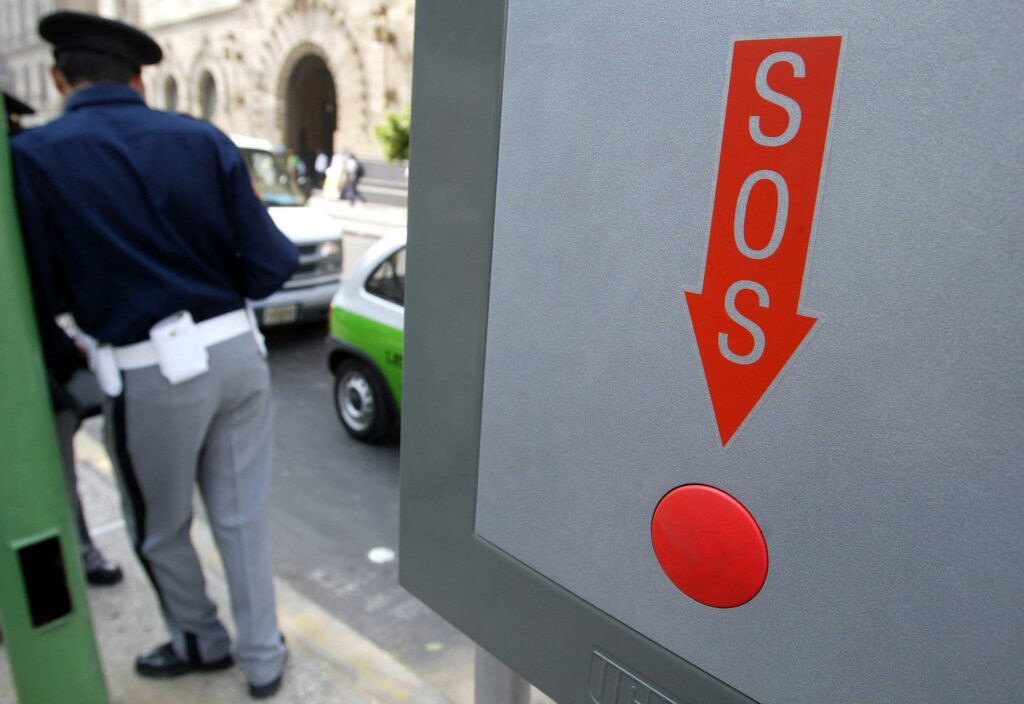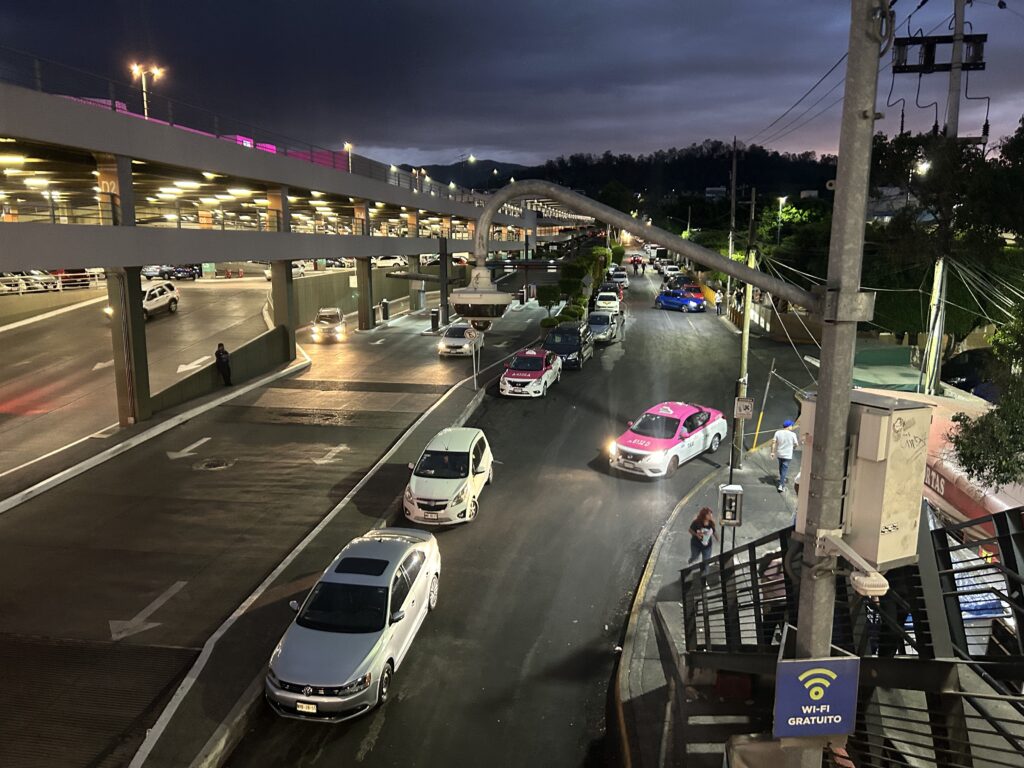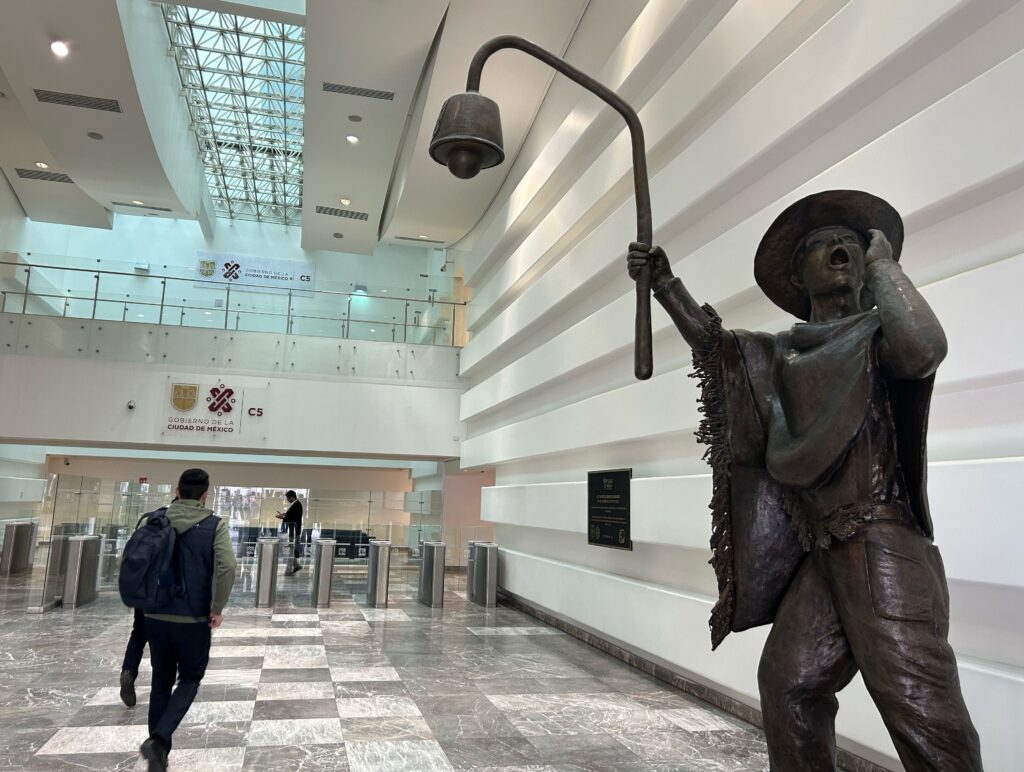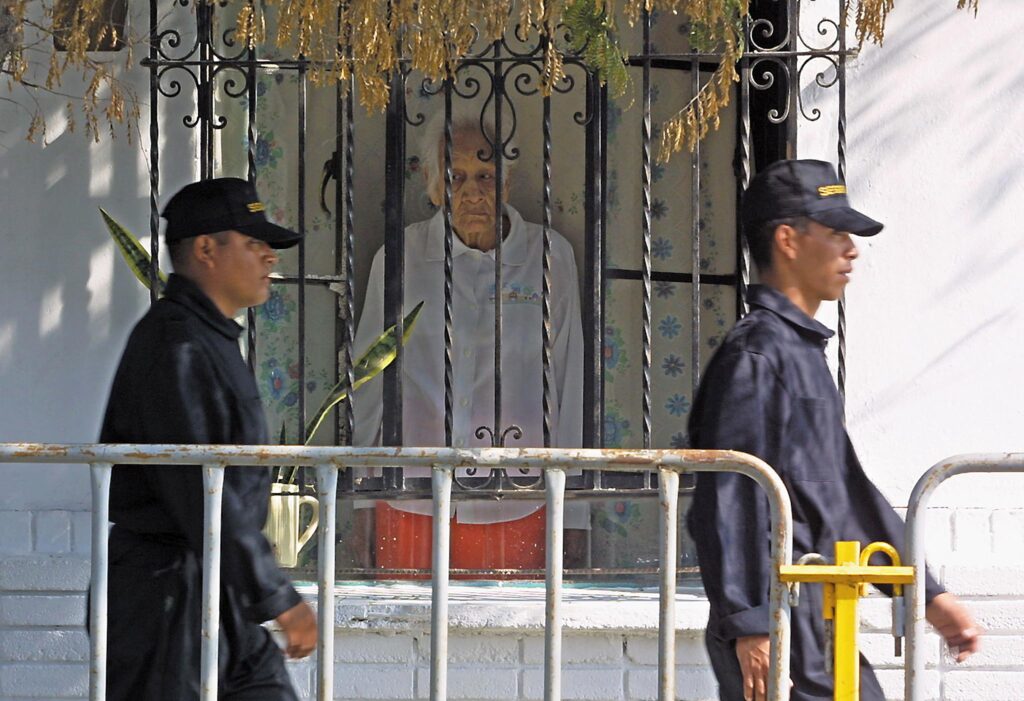Inside Mexico City’s Surveillance State

In September 2022, a criminal prosecutor in Mexico City’s most crime-ridden district sat under the fluorescent lights of her office booking an Uber driver for possession of a stolen car. Surveillance cameras had detected that the driver’s license plate was associated with a robbery report. The camera set off an alarm in one of the city’s command and control centers, where a police monitor tracked the car on a series of cameras and instructed beat officers to make an arrest.
Despite being filmed by several security cameras, the suspect seemed extraordinarily calm. He gave the criminal prosecutor all his personal information without hesitating. She even let him use her cellphone to call his boss—the car’s owner—to let him know he had been arrested. “It’s the second time this month he has been arrested for the same crime,” the prosecutor told me.
The Uber driver spent two nights in the prosecutor’s office detention cells. He was released after his boss presented the driver’s employment contract and the invoice for the car, showing it had not been stolen. Still, the blunder had cost the driver two days of wages—all because of a technical flaw in the surveillance cameras’ license plate readers. This mistake was not clarified, and the driver was released without any assurance that he would not be arrested again for the same mistake.
I saw many flawed cases like this during my two years of ethnographic research among criminal prosecutors in Mexico City. While spending hundreds of hours observing booking procedures, interviewing prosecutors, and watching judicial hearings, I realized how dramatically the government’s video surveillance cameras are transforming the criminal justice system.
Listen to a SAPIENS podcast episode about the author’s research: “The Power of Criminal Prosecutors.”
In the last decade, Mexico’s capital has installed the largest video surveillance system in the Americas. According to dozens of prosecutors I interviewed, the rate of arrests prompted by citywide cameras, government-installed panic buttons, and police officers in command centers has radically increased in the last few years.
But this system, designed to deter and prosecute crimes, is a double-edged sword. Video footage is a source of arrests. It also reveals technological weaknesses, inaccurate evidence gathering, and police misconduct. Plus, ethical concerns about social biases and mass filming are leading many people—including some in law enforcement—to question the expansion of the surveillance state.
THE RISE OF THE SURVEILLANCE STATE
In the past two decades, the city’s three leftist governments have made video surveillance a central component of their policing strategies. Amid a drug war that has intensified violent crime throughout the country, Mexico City’s administration invested more than US$400 million to install the first 8,000 cameras in 2009. By 2012, the city had around 13,000 cameras, which increased to 21,000 in 2018. This number has risen exponentially in the past five years to over 64,000.
The surveillance system is controlled from a central command and control center and seven regional dispatch centers where flesh-and-bone dispatchers monitor cameras distributed across 1,627 neighborhoods. The center receives more than 5,000 emergency calls daily and monitors the entire network of cameras, plus 13,000 panic buttons attached to camera poles.
Each regional dispatch center has around 20 police dispatchers answering calls, coordinating the response of patrol cars, inspecting cameras pointing toward crime hot spots, and looking for license plates on vehicles reported as stolen.
In the past four years, Mexico City’s government has also modernized the surveillance system, improving the quality of color video footage and enhancing storage capacity to up to 40 days. Still, surveillance technology is prone to numerous problems, from technological glitches to cognitive biases to outright cover-ups.
THE FLAWS IN SURVEILLANCE SYSTEMS
In November 2022, the same prosecutor who booked the Uber driver worked on a grand theft auto case. A couple had tried to sell their car on the internet, and the suspect claimed to be interested. When they met to make the exchange in the street, he allegedly robbed them at gunpoint.
The suspect fled in the car. The woman pressed one of the government’s panic buttons, setting off an alarm in a command center. As the man raced across the city in the car, a police monitor in the center tracked the vehicle using a series of cameras. He guided the beat officers toward it, and they arrested the man within a few minutes.
Minutes later, the crime victims, the handcuffed suspect, and the police officers stood outside the prosecutor’s office door as she waited for the central piece of evidence: the surveillance footage. “It’s objective,” she told me. “I can’t change it afterward, so it’s better to start with it and adjust the interviews according to what it shows.”
When the police monitor arrived, he showed the prosecutor the crime recording on his cellphone. She immediately called the officers making the booking and the crime victims to her office and asked them to adjust their statements to what they saw in the video. The whole criminal case hinged on that single piece of evidence.
The power that surveillance videos have quickly attained in criminal prosecution is based on their supposed objectivity. Throughout my fieldwork, prosecutors referred to surveillance footage as “factual,” “ultimate,” or “plenary”—complete and absolute—evidence. Nevertheless, camera errors and varying legal interpretations reveal how far video evidence is from objectively portraying reality.
I witnessed numerous technological malfunctions that impacted the outcomes of criminal cases: Cameras with broken recordings skipped the time frame when a crime was presumably committed. Foliage obstructed the view of a crime. The time log on the video was behind or ahead of schedule. License plate readers appeared to make errors, as in the case of the re-arrested Uber driver.
When these malfunctions occurred, prosecutors could either decide to exclude the footage as evidence and alter their cases, or present it and risk being questioned by the defense attorney or the judge. They usually chose to alter their cases, subjecting their interpretations to the “objectivity” of video recording.
Surveillance technology has also been criticized for its narrow focus on low-level street crime. Surveillance cameras only record crimes in public spaces, such as robberies and assaults. This has led experts to argue that investing in public surveillance targets certain social groups and defunds efforts to fight crimes in private spaces, such as domestic violence, organized crime, and white-collar crime.
In addition, surveillance cameras provide only partial information, sometimes leading to the arrest of innocent people. I witnessed a case in which a man was arrested for driving his motorcycle after police monitors saw a video of him struggling to start his engine and assumed he had stolen it. In another incident, police saw footage of an unhoused man dragging an iron drain down the street and booked him for theft, unaware that he had found the drain under a pile of trash.
These cases reveal the irony of video surveillance: Many prosecutors consider video footage an objective portrayal of events and the cornerstone of their case. Yet much of the prosecutorial work I witnessed consisted of contextualizing and interpreting video footage. In practice, prosecutors typically treat video evidence as part of a larger scaffolding that builds up a criminal case, along with interviews, forensic reports, and material evidence pieced together by causal inference. This indicates that video footage is quite subjective, whether or not prosecutors recognize that.
For example, video footage does not have sound. So, when a prosecutor wants to show that a suspect threatened a victim, she needs statements from the victim and witnesses. In addition, the cameras cannot record faces with precise definition. So, to convince judges about suspects’ identities in judicial hearings, the suspects are typically presented wearing the clothes they wore when they allegedly committed the crime. In one case, I saw police officers forcing suspects to wear the same denim jackets they had on when they were arrested.
Moreover, collecting surveillance footage is a complex administrative procedure. The defense must ask the prosecutor to instruct detectives to request the recordings from a command center and pick them up when they are ready. This can take several weeks, so videos sometimes arrive at court after suspects have been indicted or released.
The long chain of custody and administrative red tape means many people can sabotage video collection. I saw prosecutors delaying the collection of footage that could negatively affect their cases, and one detective commander admitted that this strategy of holding up evidence was a common practice. Prosecutors sometimes presented video evidence only after suspects were in pre-trial detention, when it was more challenging for the defense to get cases dismissed.
WHEN SURVEILLANCE REVEALS POLICE MISCONDUCT
In one case I followed during my fieldwork, police officers claimed they saw two men exchanging “small bags with green dry grass with the looks of marijuana and small bags of a crystalline solid substance with the looks of cocaine.” They immediately arrested the men. When they body-searched the suspects, they allegedly found money, marijuana, and cocaine, which they seized and presented as evidence. They booked the suspects for drug dealing.
One of the suspects’ defense attorneys collected the surveillance footage of the arrest and presented it in a judicial hearing. The video revealed that the police officers had fabricated the crime and planted the evidence.
In dozens of hearings, I saw judges dismissing cases based on surveillance footage due to legal technicalities.
In the video, the alleged seller is mopping a floor in a narrow alleyway. The other suspect is just standing outside his house. They do not interact or exchange any drugs. Suddenly, more than eight plainclothes police officers storm the alleyway. They arrest both men and force them into a patrol car.
After a judge watched the video, he ordered the immediate release of the suspects, along with a criminal investigation against the police officers for fabrication of evidence. Ironically, in such instances, video footage might become evidence in new cases against police officers.
During my research, I followed numerous cases in which surveillance footage revealed illegal arrests, prompting the suspect’s immediate release and acquittal. Police officers have been filmed tampering with videographic evidence, destroying cameras, turning cameras away from an incident, and even stealing storage drives.
DISPUTES OVER THE SURVEILLANCE STATE
For all the above reasons, the expansion of Mexico City’s video surveillance system has not gone unopposed.
Some detractors come from an unexpected place: the city’s government. Judges, prosecutors, and police officers have raised concerns about the permanent surveillance of public spaces, even as elected politicians have justified it for crime control.
In dozens of hearings, I saw judges dismissing cases based on surveillance footage due to legal technicalities. A typical argument was that video could not serve as evidence because, according to Mexican law, an arrest can be legally justified only when the suspect is pursued “materially and uninterruptedly.” Video footage constitutes a “virtual” rather than a “material” chase. And tracking down a suspect by viewing different cameras—some of which have blind spots—does not constitute an uninterrupted chase. Based on this argument, judges often declared that the arrests were not made legally and dismissed the cases.
When I spoke with José Luis Hernández, the director of strategic management and interpretation at Mexico City’s main command center, he said they had tried to overcome the problem of blind spots by adding more camera poles and more cameras to each pole. The latest surveillance poles can have up to seven cameras with a 360-degree view extending to 500 meters.
Several prosecutors with decades of experience complained that the police’s dependence on video has diminished detectives’ use of traditional investigative techniques, such as field interviews and developing networks of informants that allow them to prosecute complex cases. Instead, the prosecutors said, video surveillance is limited to cases in which police can catch suspects red-handed and arrest them immediately. This overreliance on video surveillance could be shifting the focus away from prosecuting crimes that are more complex, far-reaching, and harmful to society. As one former district attorney said, “If the only tool you have is a hammer, you will treat everything as a nail.”
Hernández agreed that the police department prefers arrests made immediately after the crime. “They are easier, cheaper, and less time-consuming,” he said. “They increase police officers’ productivity so they can be back in the street very quickly.”
Studies about whether surveillance cameras deter crime produce mixed results. Nevertheless, support for the system is widespread among an electorate anxious about crime in public spaces. Eighty-three percent of Mexico City’s population considers crime their most important concern, according to a 2022 survey on crime victimization by the National Institute of Statistics and Geography.
In many neighborhood security meetings I attended, people demanded more surveillance cameras. In one meeting, a woman told elected officials, “We need cameras, more police vigilance—something that will finally solve the security problem.”
This demand is reflected in the city’s participatory budget, which allows residents to determine how to allocate certain public funds. Each year for several years, the second-most popular project proposals have been security-prevention strategies, including surveillance cameras.
Furthermore, according to many prosecutors I interviewed, the increase in arrests caused by security cameras allows elected officials to present concrete statistics to the electorate, showing that they are doing something to fight crime—even if many of these arrests are ultimately not prosecuted.
Surveillance technology also advances a growing crime control strategy in Latin America today: Empower the police to make immediate arrests regardless of the consequences to the prosecutors and judges who are in charge of keeping the system and the police in check.
By the end of 2024, Mexico City’s government has promised to have at least 80,000 cameras. And in February 2023, the mayor inaugurated a new command center downtown.
The popularity of surveillance in Mexico City has expanded to other Mexican cities such as Puebla, Guadalajara, and Monterrey, which have installed their own surveillance systems. In addition, one of the top candidates for the 2024 presidential elections has made expanding video surveillance a central strategy of his security agenda. He has promised to install, throughout the country, cameras that allow facial recognition, gun detection, license plate reading, and even “the morphological recognition of criminals because of the way they walk.”
Despite the critiques and shortcomings, the expansion of Mexico’s surveillance state seems unstoppable.

































